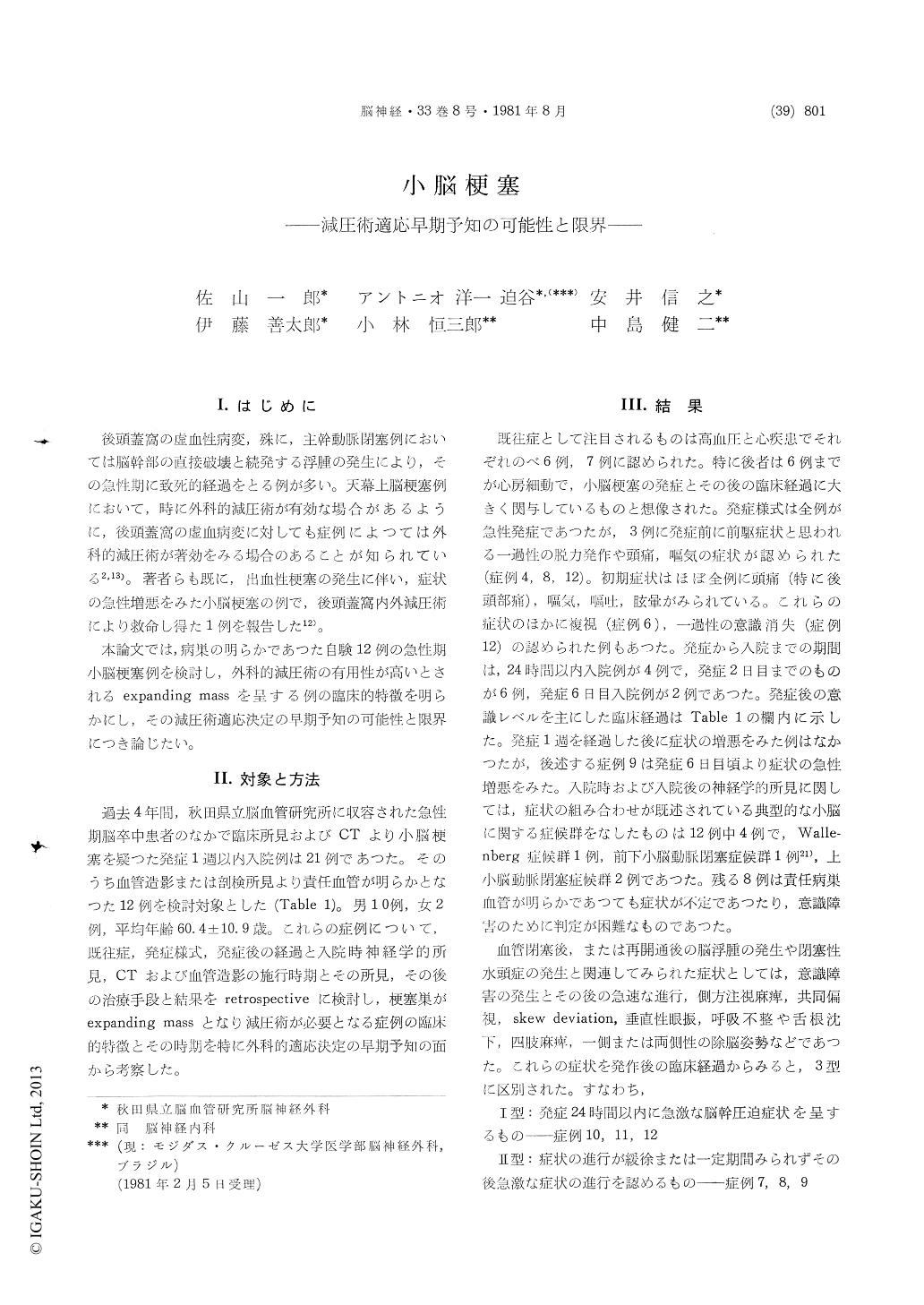Japanese
English
- 有料閲覧
- Abstract 文献概要
- 1ページ目 Look Inside
I.はじめに
後頭蓋窩の虚血性病変,殊に,主幹動脈閉塞例においては脳幹部の直接破壊と続発する浮腫の発生により,その急性期に致死的経過をとる例が多い。天幕上脳梗塞例において,時に外科的減圧術が有効な場合があるように,後頭蓋窩の虚血病変に対しても症例によつては外科的減圧術が著効をみる場合のあることが知られている2,13)。著者らも既に,出血性梗塞の発生に伴い,症状の急性増悪をみた小脳梗塞の例で,後頭蓋窩内外減圧術により救命し得た1例を報告した12)。
本論文では,病巣の明らかであつた自験12例の急性期小脳梗塞例を検討し,外科的減圧術の有用性が高いとされるexpanding massを呈する例の臨床的特徴を明らかにし,その減圧術適応決定の早期予知の可能性と限界につき論じたい。
Ischemic events in the posterior fossa due to main cerebellar arterial occlusion may sometimes be fol-lowed by fatal sequela in the acute stage. Cerebellar edema with its complications may be controlled by posterior fossa decompression. Since Lindgren (1956) first reported an successful surgical treatment in patients with cerebellar infarction, several authors have described similar cases (2, 4, 13, 18, 19, 24).
In this report, we present twelve cases with cerebellar infarction which admitted to our clinic within on week from the onset. The patient ma-terial consists of ten men and two women, mean age of 60 years, ranged 34 to 75. Six patients had hypertension and six had atrial fibrillation.
The steno-occlusive sites were as follows: 2 verte-bral (VA), 3 posterior inferior cerebellar (PICA), 1 anterior inferior cerebellar (AICA), 2 common stem of PICA and AICA, 4 superior cerebellar (SCA).
Seven of these patients were treated conservati-vely, four were treated with posterior fossa de-compression. All of them had uneventful recovery. However, one case in which only continuous ven-tricular drainage was undertaken, died one week after the onset.
In eight cases, cerebellar edema was found at neuroradiological examination, sometimes without concomitant neurological deterioration.
Edema in the posterior fossa might be accompa-nied by obstructive hydrocephalus with aggravation of the patients' condition. Therefore the existence of hydrocephalus is important in deciding for early posterior fossa decompression. The patients were devided into three types according to their clinicalcourse in the early stage as already mentioned by Feely (1979). Mild cases which sometimes mimicked a benign labyrinthine disorder could be treated conservatively. Most of these cases had relatively good collateral blood flow and/or generalized cere-bral atrophy. However, once recanalization occurs in the early stage, massive brain swelling will develop to need posterior fossa decompression.
The more severe cases with rapid clinical deter-ioration within 24 hours after the ictus had to undergo life-saving surgical decompression.
Patients who needed surgical decompression often had a history of atrial fibrillation and suffered from embolic occlusion of cerebellar arteries. Further-more, when CT scan performed within 24 hours showed low density area with mass signs, surgical intervention was inevitable.

Copyright © 1981, Igaku-Shoin Ltd. All rights reserved.


